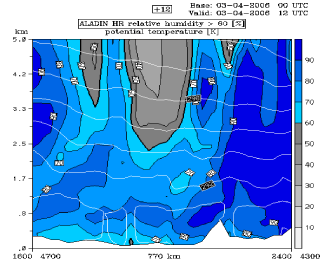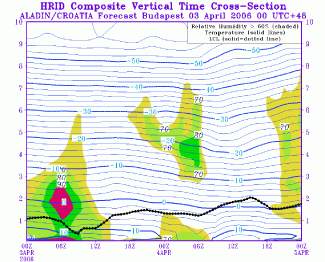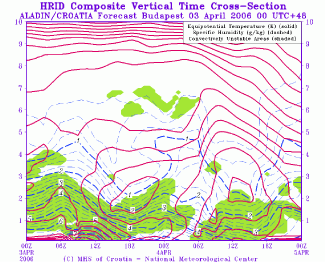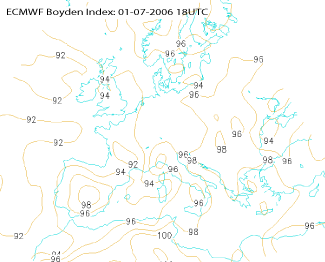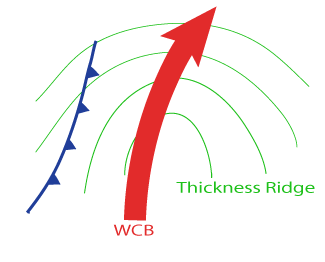Meteorological Physical Background
Cb Clusters in Warm Air, which are the subject of this investigation, are mesoscale cloud phenomena with an average diameter of 200 km. Over
land they start to be generated when the surface temperature enhanced by insolation becomes sufficient to trigger convection. They dissolve
during night, and this is one of the main characteristics to differentiate them from MCSs which can exist during the night and even in the
morning. They appear most frequently in summertime over land, but they also emerge over the sea during the whole year, day or night. Cb
Clusters in Warm Air do not arise at the boundary of two air masses such as Fronts, but develop ahead of the Cold Front in the warm air of a
thermal ridge. Cb Clusters are often embedded in cellular low cloudiness of other types. In contrast to MCS, single Cbs are usually well
separated from each other allowing easy detection in radar images.
The synoptic environment shows great resemblance with that of an MCS (see
Cumulonimbus (Cb) and Mesoscale Convective System (MCS) - Meteorological Physical Background
). In fact, Cb Cluster is often a preliminary stage in the life cycle of an MCS.
|
Mature Stage of a Cb Cluster
|
MCS
|
Life cycle of a Cb Cluster in Warm Air
|
09 July 2006/10.45 UTC - Meteosat 8 HRVIS image
|
09 July 2006/12.45 UTC - Meteosat 8 HRVIS image
|
|
09 July 2006/17.00 UTC - Meteosat 8 HRVIS image
|
|
|
09 July 2006/10.00 UTC - Meteosat 8 HRVIS image; 10.00 UTC - 17.00 UTC quarter-hourly image loop
|
09 July 2006/10.00 UTC - Radar image; 10.00 UTC - 17.00 UTC quarter-hourly image loop
|
A life cycle of Cb Clusters can be seen in the example above. An individual cell started developing in central part of northern Croatia around noon local time (10UTC) on 09 July 2006. Soon, the other cells started to emerge and a cluster, which can be seen in 12.45 UTC image, was formed. This cluster, like many others appearing that day, decayed in the evening. In the same air mass a Cb Cluster in Western Austria, closer to the Cold Front approaching from Western Europe, experienced the full development from Cb cluster into an MCS. These complete life cycles are often observed in the areas close to the Cold Front where cold air advection at higher levels plays an important role.
A Cb Cluster developing into an MCS
|
03 April 2006/10.00 UTC - Meteosat 8 HRVIS image
|
03 April 2006/10.00 UTC - Meteosat 8 IR10.8 image with nowcasting product Convective Cell Detection
|
|
03 April 2006/11:45 UTC - Meteosat 8 HRVIS image
|
03 April 2006/11:45 UTC - Meteosat 8 IR10.8 image with nowcasting product Convective Cell Detection
|
|
03 April 2006/12:30 UTC - Meteosat 8 HRVIS image
|
03 April 2006/12:30 UTC - Meteosat 8 IR10.8 image with nowcasting product Convective Cell Detection
|
The above example shows the full life cycle of a convective system. In the unstable air of a thermal ridge, individual Cbs started to appear in southern Austria and Slovenia in the late morning hours of 03 April 2006, and around midday, as seen in the 10.00 UTC image, they already grew to become a well developed cluster. In the right column Meteosat 8 IR 10.8 satellite images with nowcasting product Convective Cell Detection overlaid can be seen. Nowcasting algorithm used in this investigation detects convective cells on the basis of their temperature and radius, with three temperature thresholds where blue cross indicates the cell with cloud top temperature lower than -33°C, yellow lower than -42°C and red lower than -50°C. It can be noticed that the cluster is developing quite rapidly taking about 4 hours to become a MCS covering the area of Slovenia, southern Austria and eastern Italy.
The environment favorable for the development of Cb Clusters
The favourable area for the development of Cb clusters is characterized by an unstable humid air mass.
|
Average of the min and max values of relative humidity
|
Average height of the min and max of relative humidity
|

|

|
As shown in the sketches, in most cases, relative humidity values in the lower layers are very high, indicating also big amount of precipitable water. In the investigated cases an average of about 30mm was found, with a dispersion of 10mm.
The average height of the potentially unstable layer is characterized by the more or less pronounced inversion of the potential temperature. In the investigated cases a common height of this inversion was 700 hPa.
|
03 April 2006/12.00 UTC - Meteosat 8 HRVIS image; position of vertical cross sections indicated
|
03 April 2006/12.00 UTC Radio Sounding Budapest
|
|
03 April 2006/12.00 UTC - ALADIN model vertical cross section A; grey shaded: wind speed, wind barbs: wind direction
|
03 April 2006/12.00 UTC - ALADIN model vertical cross section B; white: isentropes, blue and grey shaded: relative humidity
|
|
03-04 April 2006 - ALADIN model time vertical cross section for Budapest; black-dotted: LCL, blue: temperature and shaded: relative
humidity
|
03-04 April 2006 - ALADIN model time vertical cross section for Budapest; magenta: equipotential temperature, blue dashed: specific
humidity and green shaded: convectively unstable area
|
The only available radio sounding in the area of interest, Budapest, shows a pronounced very unstable and humid lower troposphere.
The area with high humidity is present in ALADIN model spatial cross section B and even more pronounced in the vertical time cross sections for Budapest. Furthermore, potential instability can be seen in the vertical distribution of isentropes. In time cross section, it can be clearly recognized as the area of backward inclined isentropes with values decreasing with height, sometimes even a closed isoline indicating the minimum in the level between 3 and 4 kilometers. Also, vertical wind shear in speed and direction, shown in spatial Vertical Cross Section A, is necessary for the development of thunderstorms (see Cumulonimbus (Cb) and Mesoscale Convective System (MCS) - Meteorological Physical Background , the Role of vertical wind shear).
Instability of the atmosphere is often described by different instability indices. In the description of this conceptual model the most common ones, Showalter Index, K Index and Boyden Index are used. Indices themselves may be misleading, and using them one must be aware that they give only an indication of the possibility for convective activity.
|
01 July 2005/18.00 UTC - Meteosat 8 IR10.8 image
|
01 July 2005/18.00 UTC - synop observations in the area of interest
|
|
01 July 2005/18.00 UTC - ECMWF model analysis field, Showalter index
|
01 July 2005/18.00 UTC - ECMWF model analysis field, Boyden index
|
|
01 July 2005/18.00 UTC - ECMWF model analysis field, K index
|
|
The unstable environment favourable for the occurrence of Cb clusters in Warm Air can be recognized by a thickness ridge (see Cumulonimbus (Cb) and Mesoscale Convective System (MCS) - Meteorological Physical Background ) and a ridge in the potential temperature
|
Environment favourable for development of convection, potential temperature and thickness field
|
01 July 2005/18.00 UTC - ECMWF model analysis field, equivalent potential temperature 850 hPa
|
|
01 July 2005/18.00 UTC - ECMWF model analysis field, equivalent thickness
|
|
The driving mechanism for development of Cbs in Warm Air is the surface heating. Differential heating of the earth surface causes the formation
of a trough in the surface pressure field which leads to convergence in the lower levels. This will certainly accelerate the development,
especially in moist areas.
Orographic effects in mountainous terrain also play an important role in this convergence mechanism.
|
Environment favourable for development of convection, surface trough and convergence zone
|
01 July 2005/09.00 UTC - ALADIN model forecast field, wind and geopotential 1000 hPa
|
|
01 July 2005/18.00 UTC - ALADIN model forecast field, divergence 1000hPa
|
01 July 2005/18.00 UTC - ALADIN model forecast field, divergence 850hPa
|
In most cases, warm advection in lower levels is almost negligible, as shown in the diagram. Nevertheless, cold advection at higher levels can contribute to the triggering of Cbs, especially during the preliminary stage of an MCS. In such cases a Warm Conveyor Belt in the lower levels in front of the Cold Front also plays a role in destabilizing the atmosphere.
|
Average values of temperature advection
|
Diagram showing Warm Advection in lower layers by Warm Conveyor Belt (WCB)
|
















